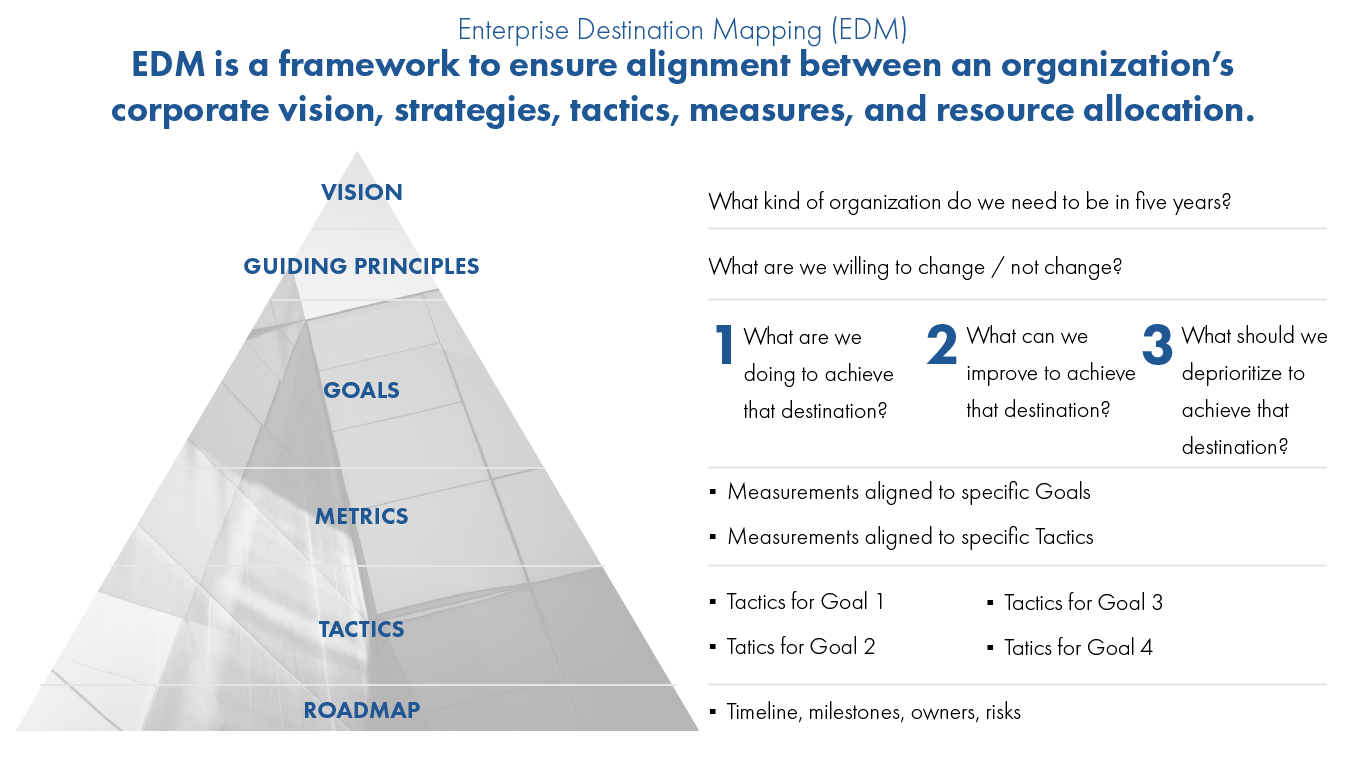Establishing Strategic Goals, Metrics, and Tactics with Enterprise Destination Mapping
Our Enterprise Destination Mapping (EDM) methodology is a framework that articulates an organization’s ambition using strategic imperatives, supporting pillars, and specific steps to drive a transformation. As part of our four-part series on EDM, we first discussed developing a Vision Statement and defining Guiding Principles to help establish the “why” for your organization’s strategic change. In this piece, we will focus on how to establish strategic goals, metrics, and tactics that will help to determine the “what” behind this change, and in our final piece of the series, the roadmap will help lay out the “how.”

Once an organization develops its vision and establishes its guiding principles, the next step is to define the strategic goals that need to be executed, along with metrics (KPIs) and tactics that accompany those goals to measure progress and outcomes. We define goals, metrics, and tactics as the following:
- Goals: Specific statements that stakeholders expect to achieve or attain; the goals clearly articulate the short-, mid-, or long-term objectives required to achieve the vision.
- Metrics: The ways in which we measure both progress and success of stated goals; metrics quantifiably measure, track, monitor, and assess the success of an initiative.
- Tactics: The individual steps and actions that will be taken to achieve stated goals in line with the overarching vision.
Developing Goal Statements Required to Achieve the Vision
When an organization knows where it’s heading and stakeholders are aligned with the vision, the next step is to define the activities that will enable the business to achieve its vision. Important questions to consider when establishing strategic goals include:
- At an operational level, what must we do differently or better to achieve our desired vision?
- What should we stop or deprioritize to achieve that vision?
Goals should be clearly defined to ensure that your objectives are attainable within a certain time frame. SMART (specific, measurable, achievable, relevant, time-based) goals eliminate generalities and guesswork, make it easier to track progress on the efforts, identify missed milestones, and set a clear timeline. These goals will become key “themes” or “pillars” that support the overarching vision. Let’s look at an example of what a goal for Patagonia may look like considering its vision statement:

When considering where to start when developing goals, think about broad themes, departments, or segments of the business, which could include financial, operational, marketing, customer, and/or employee engagement related goals.
Assigning Metrics to Measure Progress Against Goals
Once goals are established, metrics should be assigned to measure the progress and success of stated goals. Strategic questions to consider when developing metrics include:
- How do we measure success of this change? Can we define targets by metric for years 1, 3, and 5?
- How do we measure progress in executing the vision?
Stakeholders at varying levels of leadership require different metrics to provide an appropriate view of progress and success against business goals. Metrics can range from strategic-level business outcomes down to detailed operational levers used to prioritize projects and team-level optimization.
- Level One (Business Outcomes): Measures organizational maturity and sustainability of stated goal.
- Level Two (Strategic Levers and Macro Performance): Measures performance of cross-functional efforts.
- Level Three (Operational Levers and Diagnostics): Diagnose cross-functional issues and opportunities to plan and prioritize projects and investments.
- Level Four (Tactical Levers and Optimization): Measures performance of departments, teams, regions, and other divisions of the organization.
Specific metrics should be mapped back to each goal, with the intent that they are clearly defined and differentiated. Metrics can be used to measure success of the goal as well as progress of executing the vision and goals. Sticking with the example of Patagonia, we can see how an example of progress metrics and success metrics can be applied to the vision and goal:

Over a set of collaborative sessions with impacted stakeholders, metrics should be defined considering the timeframe (e.g., within a year or over a three-year period) as well with expectations around how metrics may evolve overtime. Some considerations that can impact metric evolution include strategic decisions, dependencies, resource constraints, and risks. Finally, it’s important to leverage any existing data that can be used to baseline where performance is today. If this data isn’t readily available, then consider using industry or competitor benchmarks to inform what a realistic metric should look like for your organization.
Aligning Tactics to Goals
Finally, tactics are the individual activities/steps that the organization will take to achieve the stated goals. Strategic questions to consider when developing metrics include:
- What are the most critical and specific activities we need to perform to achieve the stated vision and goals?
- What is the right mix of incremental vs. breakthrough ideas, and how can we achieve breakthrough innovation?
The first phase in aligning tactics to each goal is to take inventory of existing organizational tactics and map them to the list of goals. Consider each impacted functional area to gather a holistic list of tactics across people, process, and technology. Part of this exercise should also include identifying any existing tactics that don’t serve the organization’s vision and goals.
The next phase involves identifying any additional tactics that would best serve the stated goals. It’s best to look at new tactics by evaluating both incremental and breakthrough innovation ideas. In some instances, we facilitate this exercise by leveraging our Strategic Innovation methodology. The final phase for tactics development is to prioritize them based on difficulty to execute and impact on the organization.
Looking Ahead: Establishing Strategic Goals
Now we have all the tools to start building a roadmap as we have completed three out of four elements of the series about Enterprise Destination Mapping (EDM). True transformation in organizations comes with the intention of creating a thoughtful and realistic vision and the commitment of all parties involved, especially key stakeholders and leaders who will contribute to the success of the business. With the Enterprise Destination Mapping methodology, we have helped our clients accomplish strategic transformation providing organizational resilience navigating uncertainty.
To learn more about our EDM methodology, connect with our team today.
Subscribe to Clarkston's Insights
Contributions from Hugo Rincon



